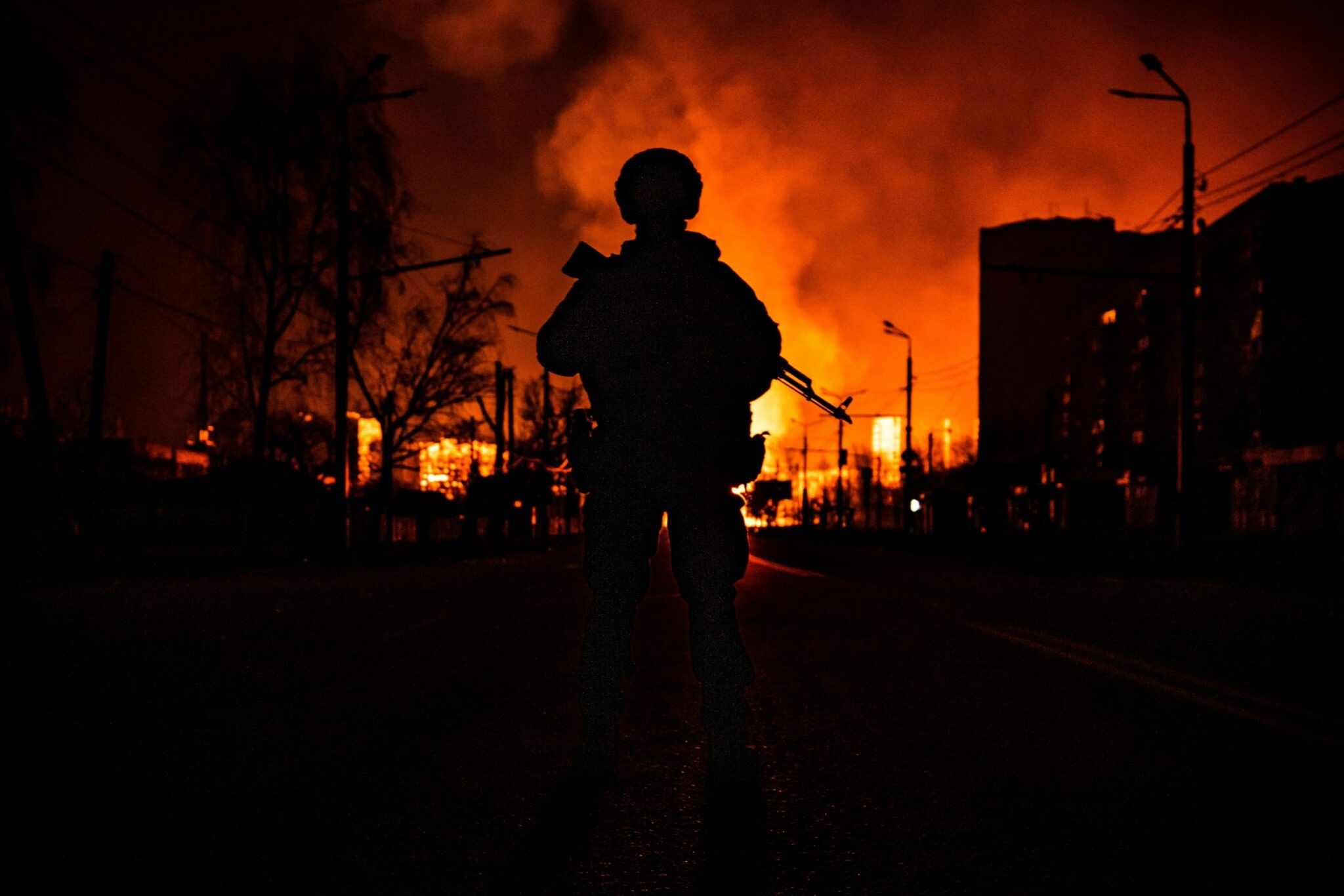Explosions heard in Kyiv
The Guardian’s Charlotte Higgins is in Kyiv, where she has heard at least three explosions this morning.
On Telegram, Kyiv mayor Vitali Klitschko wrote:
“The explosion in the Shevchenkiv district – in the center of the capital. All services follow in place. Details later. The air alert continues. Stay in shelters!”
The Shevchenkivskiy district is the same area that was hit by several explosions a week ago, on 10 October. At least 19 people were killed in last week’s attacks on Kyiv and more than 100 were injured.
Key events
What are Kamikaze drones?
Andriy Yermak, the head of the Ukranian president’s office, confirmed this morning that the attacks on Kyiv were carried out using Kamikaze drones.
Here is the Guardian’s Peter Beaumont on how the drones work – and Russia’s escalating use of these weapons in the war:
“The capital was attacked by kamikaze drones,” he said. “We need more air defence systems and as soon as possible. We have no time for slow actions. More weapons to defend the sky and destroy the enemy.”
Usually launched in pairs, the 200kg Kamikaze drone – which is armed with a warhead, officially has claimed range of about 2,000km although realistically it is believed to be closer to several hundred with anecdotal evidence suggesting that Ukrainian forces have at times struggled to track the incoming drones.
In a recent interview Oleg Katkov, of Ukraine’s Defense Express, suggested the drones were probably relatively low-tech, assembled from parts that could be bought easily online and guided by a civilian GPS system, with their effectiveness coming from their use in swarms.
“Since this equipment is assembled from low-quality parts, the reliability will be low. That is why the tactics of using these UAVs [unmanned aerial vehicles] involves their use in a so-called swarm. In other words, five to six, or even more, kamikaze drones are launched at one target, assuming that a few of them will fulfil their task.”
Charlotte Higgins
Here is our report on this morning’s attacks:
Kyiv has been hit by a series of explosions, just days after Russia’s president Vladimir Putin promised there would be “no need for more massive strikes” on Ukraine.
Kyiv’s mayor Vitaliy Klitschko confirmed two blasts sounded in the city’s central Shevchenkiv district in a series of statements posted to his Telegram channel just before 7am on Monday.
Air raid sirens sounded in Kyiv at 6.25am, an almost daily occurrence, frequently ignored by citizens. This time however, they were swiftly followed by a series of explosions between 6.35am and 6.58am (0335 GMT and 0358 GMT). A second series of blasts was heard by Guardian correspondents at about 815am local time (615am BST).
Klitschko said that “as a result of the drone attack, a fire broke out in a non-residential building in the Shevchenkiv district” and several residential buildings were also damaged.
Andriy Yermak, the head of the president’s office, confirmed the attack in a Telegram post just after 7am.
“The capital was attacked by kamikaze drones,” he said. “We need more air defence systems and as soon as possible. We have no time for slow actions. More weapons to defend the sky and destroy the enemy.”
“The Russians think that this will help them but these actions look more like agony,” he said.
Emergency services were reportedly clarifying information about any possible victims.
The head of Ukraine’s state railway, Alexander Kamyshin, said some strikes hit near Kyiv’s central station. Scores of people sheltered in an underpass at the station.
Attacks in Zaporizhzhia overnight
Anatoly Kurtev, Zaporizhzhia City Council secretary, has just posted on Telegram that there was an attack on the city overnight, but that so far no injuries or casualties have been reported.
“Tonight, during the air raid, the racist occupiers launched an attack on the outskirts of the city and the suburbs.
According to preliminary data, there are no destructions and no injured people.”
Ninth drone strike on Kyiv as attacks continue
The Guardian’s Daniel Boffey reports that a ninth strike has hit Kyiv.
The Guardian’s Daniel Boffey says he is hearing reports there have been eight strikes on Kyiv this morning.
Reports from further afield suggest total drone attacks on city stands at eight
— Daniel Boffey (@danielboffey) October 17, 2022
If you’re just joining us, Russia launched strikes on Ukraine’s capital Kyiv early on Monday morning. Residential buildings were damaged in the strikes, some of which occurred near Ukraine’s central railway station.
“Several residential buildings were damaged. Medics are on the spot,” Kyiv Mayor Vitali Klitschko said in a post on Telegram.
No casualties have been reported yet.
The Guardian’s Daniel Boffey reports that a fifth drone has just flown over Kyiv and landed “with a bang” after Ukrainian soldiers were unable to shoot it down:
Just had a fifth drone now in Kyiv. Watched as soldiers sought to shoot it down but it avoided machine gun fire and landed with a bang
— Daniel Boffey (@danielboffey) October 17, 2022
More blasts heard in Kyiv
The Guardian’s Charlotte Higgins, who is in Kyiv, has just heard more blasts. More on this shortly.
Kyiv mayor Vitali Klitschko has posted a photograph on Twitter of “the wreckage of one of the kamikaze drones that attacked Kyiv this morning”.
Уламок одного з дронів-камікадзе, які сьогодні зранку атакували Київ. pic.twitter.com/EV1Hy6GADL
— Віталій Кличко (@Vitaliy_Klychko) October 17, 2022
Zelenskiy says Russian deaths ‘approaching 65,000’
In an update on Sunday night, Ukraine’s president, Volodymyr Zelenskiy, said almost 65,000 Russians had been killed since Putin’s invasion of Ukraine on 24 February. This figure is far higher than Moscow’s official estimate – released on 21 September – of 5,937 dead.
“The total losses of the enemy in terms of killed people are approaching 65,000. So many citizens of Russia gave their lives for the possibility of a handful of people in the Kremlin to ignore reality,” Zelenskiy wrote.
Estimates of the number of Russian soldiers killed in the war vary. In July, Colin Kahl, the US Under Secretary of Defence for policy, said estimated that up to 80,000 Russians had been killed or injured. It was believed that roughly a quarter of these were killed, two US officials told the New York Times.
EU foreign ministers to discuss transfer of Iranian drones to Russia – Reuters
European Union foreign ministers are expected to agree on a mission to train 15,000 Ukrainian troops from next month and an extra €500m worth of funding for arms deliveries to Kyiv when they meet in Luxembourg on Monday, Reuters reports.
Several EU countries have already been instructing Ukrainian troops on how to use specific weapons and this will continue.
The European Union has supported Kyiv since the start of the war with financial and, in a first for the bloc, military aid.
The foreign ministers will agree to add a further €500m ($486 million) to a fund that reimburses EU member states for arms delivered to Ukraine, bringing the total amount earmarked for arms for Kyiv to over €3bn.
Unlike earlier tranches, the additional money will also cover costs for repair and maintenance of weapons already delivered to Ukraine.
EU foreign ministers will also discuss the transfer of Iranian drones to Russia, opening the way for potential further sanctions that could be agreed at a later date.
The UK Ministry of Defence says in its latest update that Russia is “likely” facing more acute logistical challenges as a result of the Kerch bridge bombing on 8 October.
“A large queue of waiting cargo trucks remains backed up near the crossing,” the ministry reports.
Conflict has pushed four million children into poverty, says UN
Russia’s invasion of Ukraine and its economic fallout have thrown four million children into poverty across eastern Europe and central Asia, the UN children’s agency, Unicef, has said.
“Children are bearing the heaviest burden of the economic crisis caused by the war in Ukraine,” Unicef said.
The conflict “and rising inflation have driven an additional four million children across eastern Europe and Central Asia into poverty, a 19 percent increase since 2021”.
Russian and Ukrainian children have been most affected since Moscow’s attack on its neighbour in February.
“Russia accounts for nearly three-quarters of the total increase in the number of children living in poverty due to the Ukraine war and a cost-of-living crisis across the region, with an additional 2.8 million children now living in households below the poverty line,” Unicef reported.
The blow to Russia’s economy from western sanctions had combined with its large population to exacerbate the effects.
“Ukraine is home to half a million additional children living in poverty, the second largest share,” Unicef said.
Romania followed closely behind, with a further 110,000 children in poverty.
















